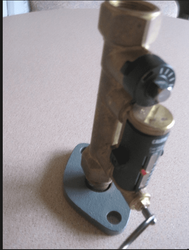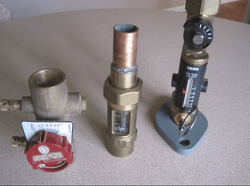Probably the most frustrating thing about hydronics is an under-performing or non performing system.
More often that not an no flow condition is caused by an air bubble somewhere in the piping. This can be a tough problem to diagnosis and eliminate as it is sometimes re-occuring. Purge, purge, purge, and the heat is on. Days or weeks later the problem returns.
Or a pump that is seized or has a broken cermaic shaft.
Doing some math can determine what flow you should have. Pump curves can be helpful in determining how much flow (gpm) is moving in a piping system.
System overlays can show the OP, "operating point" on a pump curve in relationship to your system. Simulation software can also help you design and predict flows.
Where it gets a bit tricky is when you are standing looking at a pump and piping system and it is not doing what you expected.
With some basic tools you can determine delta T or temperature drop and get in the ball park as to what flow you have.
Another method is a flowmeter. These devices are commonly used in commercial applications where a building needs to be balanced. Consider a large commercial hotel installation in Vegas for example. Every floor and every room heat emitter will have a means to read and adjust flow. It's the only way to make the system perform properly and efficiently. It also provides a means to troubleshoot.
There are a good selection of inexpensive and dependable flow meters and setters on the market that can be used in smaller applications.
Sometimes you see the small ones on radiant manifolds to balance a multi loop installation.
All of the pre-fab solar pump stations have flowmetters so you can dial in the pump speed, and also do some energy metering calculations.
Most of the hydronic manufacturers offer basic flowsetters from 1/2" - 2" A flow setter allows you to read, and adjust the flow. A flowmeter is just an indicator.
I've started adding flow setters to my system just to see how accurate the calculations match the real time condition. I've been surprised to find the flowrates are usually higher or lower than predicted when you actually 'read" them with a meter or setter. It is also helpful with variable speed pumps, or multi-speed pumps.
My latest thinking is to match a flowsetter with a pump flange. This give you a means to read, and fine tune the flowrates. It takes the "unknown" out as well as the frustration. It doubles as your isolation for the pump also.
Here is a 3/4" 0-7 gpm example. Ideally you want 5 pipe diameters between the pump discharge and setter, this is an experiment to see if a close connection changes the reading much.
While not "lab quality" it gets the installer and troubleshooter within a 10% accuracy, generally.
hr
More often that not an no flow condition is caused by an air bubble somewhere in the piping. This can be a tough problem to diagnosis and eliminate as it is sometimes re-occuring. Purge, purge, purge, and the heat is on. Days or weeks later the problem returns.
Or a pump that is seized or has a broken cermaic shaft.
Doing some math can determine what flow you should have. Pump curves can be helpful in determining how much flow (gpm) is moving in a piping system.
System overlays can show the OP, "operating point" on a pump curve in relationship to your system. Simulation software can also help you design and predict flows.
Where it gets a bit tricky is when you are standing looking at a pump and piping system and it is not doing what you expected.
With some basic tools you can determine delta T or temperature drop and get in the ball park as to what flow you have.
Another method is a flowmeter. These devices are commonly used in commercial applications where a building needs to be balanced. Consider a large commercial hotel installation in Vegas for example. Every floor and every room heat emitter will have a means to read and adjust flow. It's the only way to make the system perform properly and efficiently. It also provides a means to troubleshoot.
There are a good selection of inexpensive and dependable flow meters and setters on the market that can be used in smaller applications.
Sometimes you see the small ones on radiant manifolds to balance a multi loop installation.
All of the pre-fab solar pump stations have flowmetters so you can dial in the pump speed, and also do some energy metering calculations.
Most of the hydronic manufacturers offer basic flowsetters from 1/2" - 2" A flow setter allows you to read, and adjust the flow. A flowmeter is just an indicator.
I've started adding flow setters to my system just to see how accurate the calculations match the real time condition. I've been surprised to find the flowrates are usually higher or lower than predicted when you actually 'read" them with a meter or setter. It is also helpful with variable speed pumps, or multi-speed pumps.
My latest thinking is to match a flowsetter with a pump flange. This give you a means to read, and fine tune the flowrates. It takes the "unknown" out as well as the frustration. It doubles as your isolation for the pump also.
Here is a 3/4" 0-7 gpm example. Ideally you want 5 pipe diameters between the pump discharge and setter, this is an experiment to see if a close connection changes the reading much.
While not "lab quality" it gets the installer and troubleshooter within a 10% accuracy, generally.
hr



